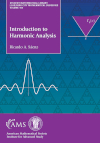- About MAA
- Membership
- MAA Publications
- Periodicals
- Blogs
- MAA Book Series
- MAA Press (an imprint of the AMS)
- MAA Notes
- MAA Reviews
- Mathematical Communication
- Information for Libraries
- Author Resources
- Advertise with MAA
- Meetings
- Competitions
- Programs
- Communities
- MAA Sections
- SIGMAA
- MAA Connect
- Students
- MAA Awards
- Awards Booklets
- Writing Awards
- Teaching Awards
- Service Awards
- Research Awards
- Lecture Awards
- Putnam Competition Individual and Team Winners
- D. E. Shaw Group AMC 8 Awards & Certificates
- Maryam Mirzakhani AMC 10 A Awards & Certificates
- Two Sigma AMC 10 B Awards & Certificates
- Jane Street AMC 12 A Awards & Certificates
- Akamai AMC 12 B Awards & Certificates
- High School Teachers
- News
You are here
Introduction to Harmonic Analysis

Buy Now:
Publisher:
AMS
Publication Date:
2023
Number of Pages:
279
Format:
Paperback
Series:
Student Mathematical Library
Price:
59.00
ISBN:
978-1470471996
Category:
Textbook
[Reviewed by , on ]
Russell Jay Hendel
02/29/2024
This book is written for a second semester analysis course in either Harmonic Analysis or Analysis on Fractals and is targeted towards 3 rd and 4 th year undergraduates. It can also be read by practitioners interested in getting into the field. The prerequisites include courses in Linear Algebra, Calculus, and Real Analysis; students taking the course should be comfortable performing integration using polar or spherical coordinates. Knowledge of Measure Theory and Lebesgue integration is not assumed as chapters in the book are devoted to these topics. Complex analysis is neither assumed nor presented in the book. Additionally, the book provides five appendices reviewing the theory of the real line, topology, Riemann integration, Euclidean, and Complete Metric spaces.
The book is neatly divided into 13 chapters and 45 sections and is coverable in a single semester (especially if the students are already familiar with some of the material). Chapter lengths are not lengthy, about 20 pages (including exercises, bibliographical, and historical notes). A course on Fractals would require only 7 of the chapters. Diagrams and graphs are modestly provided throughout the book as needed. The book has a wonderful bibliography with historical remarks being provided for each chapter allowing an instructor to supplement the book with other material should they wish to do so. Each chapter has 10-20 exercises. The exercises are upper level and not routine; for example, exercises in the book request proving Hopf’s lemma, the Harnack inequality, Bernstein’s Theorem, and the principle of subordination. Hints are provided if exercises are especially challenging.
The book covers the basics of harmonic functions, the behavior of harmonic functions on the boundaries of their domains, presents the theory of Fourier transforms and Hilbert transforms, and provides the many varied results on convergence connected with the theory. The book chapters dealing with fractals study harmonic structure on the Sierpinski gasket using a discrete approach.
The book presents multiple approaches as applicable. For example, harmonic functions are introduced using the heat function, using the mean value property and the maximum modulus principle, and using a discrete approach.
Russell Jay Hendel holds a Ph.D. in theoretical mathematics, an Associateship from the Society of Actuaries, and a Doctor of Science in Jewish Studies. He teaches at Towson
University which is a center of actuarial excellence. His interests include discrete number theory, applications of technology to education, problem writing, actuarial science and the interaction
between mathematics, art, and poetry.)
See the publisher's website.
- Log in to post comments




